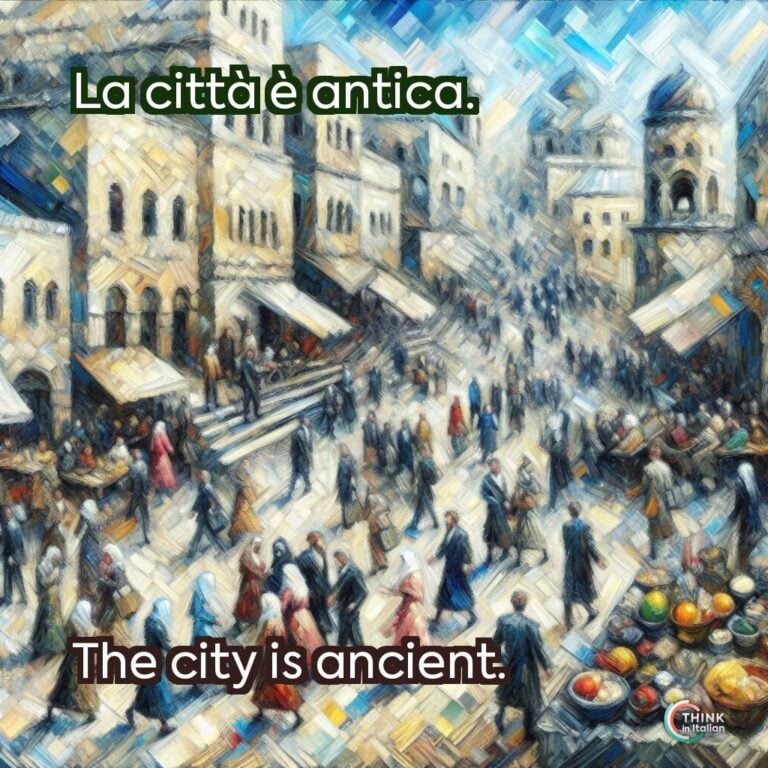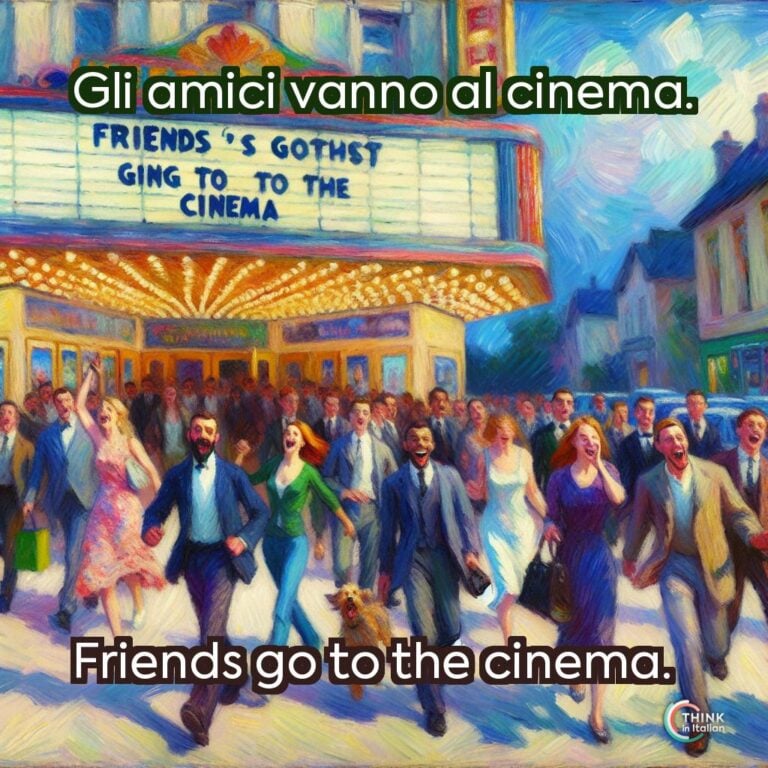Gender and Number in Italian
Italian nouns and adjectives are categorized by gender (masculine or feminine) and number (singular or plural). Unlike English, Italian nouns and adjectives must agree in both gender and number with the subject they modify.
This is why understanding how to form plurals in Italian is crucial for proper communication, as forming plurals in Italian follows specific rules based on the gender of the noun or adjective and its ending.
I promise you will soon understand the main patterns and you’ll be ready to study and understand Italian definite articles as well!
Singular to Plural
Pluralization Rules
Italian plurals are created by systematically modifying the endings of singular nouns and adjectives. The rules vary based on the noun’s gender and whether it ends in -o, -a, or -e.
As a linguist, I believe that understanding the mechanisms behind some phenomena is crucial to understand the language itself, so let me tell you something about the history of the Italian language.
From a linguistic point of view, the gender and number agreement in Italian reflects its classification as Romance language, given the fact that is evolved from Latin, just like Spanish and French among others.
In Latin, nouns were divided into declensions that governed how they changed based on case, gender, and number. Italian has simplified this system compared to Latin, but the core principle remains.
However, the typical musicality of Italian makes pluralization feel almost poetic. For me, this is one of the most beautiful aspects of the language, and it’s something that makes Italian stand out even among other Romance languages.
Regular Plurals
Here’s how the regular pluralization rules work:
- Masculine nouns ending in -o change to -i.
- Example: il libro (the book) → i libri (the books)
- Masculine nouns ending in -e (which can be either masculine or feminine) also change to -i.
-
- Example: il fiore (the flower) → i fiori (the flowers)
- Masculine adjectives follow the same rule: il ragazzo alto (the tall boy) → i ragazzi alti (the tall boys).
- Feminine nouns ending in -a change to -e.
- Example: la casa (the house) → le case (the houses)
- Feminine nouns ending in -e change to -i.
-
- Example: la notte (the night) → le notti (the nights)
- Feminine adjectives follow the same rule: la ragazza intelligente (the smart girl) → le ragazze intelligenti (the smart girls)
Invariable Plurals
Some nouns do not change form when pluralized. In linguistics, these are called invariable nouns and are often foreign words or abbreviations. Basically, they remain the same regardless of the number:
- il cinema (the cinema) → i cinema (the cinemas)
- la serie (the series) → le serie (the series).
Just like nouns, also some Italian adjectives are invariable. This often occurs with adjectives borrowed from foreign languages or certain colors and other descriptive words. For instance:
- blu (blue):
- il cielo blu (the blue sky) → i cieli blu (the blue skies)
- la macchina blu (the blue car) → le macchine blu (the blue cars)
- rosa (pink):
- il divano rosa (the pink sofa) → i divani rosa (the pink sofas)
- la sedia rosa (the pink chair) → le sedie rosa (the pink chairs)
I know invariable nouns and adjective can be confusing, they are for most of my students! But the good news is that they follow the rule of keeping the same form in both singular and plural.
Exceptions
Irregular Plurals
Some Italian plurals involve phonetic changes that are aimed at preserving specific sounds. They deviate to regular patterns, therefore I advise you properly study the main phonetic rules of the Italian alphabet.
- Nouns ending in -ca and -ga (usually feminine): to preserve the hard c or g sound, an h is added before the plural -e, for example: l’amica (the female friend) → le amiche (the female friends)
- Nouns ending in -co and -go: some add an h in the plural, while others do not, depending on pronunciation rules, for example: il lago (the lake) → i laghi (the lakes); il medico (the doctor) → i medici (the doctors).
- Adjectives ending in -co/-ca and -go/-ga: the same occurs here: bianco (white) → bianchi (plural masculine); stanco (tired) → stanchi (plural masculine); lunga (long, feminine) → lunghe (plural feminine)
- Nouns ending in -ista: they can be both masculine and feminine, but their plural forms change based on gender, for instance: il turista (the male tourist) → i turisti (the male tourists); la turista (the female tourist) → le turiste (the female tourists).
- Adjectives ending in -ista: these adjectives remain the same in the singular form, regardless of gender, but change in the plural, as in: il ragazzo ottimista (the optimistic boy) → i ragazzi ottimisti (the optimistic boys); la ragazza ottimista (the optimistic girl) → le ragazze ottimiste (the optimistic girls)
Feminine Nouns Ending in -o
Though rare, some feminine nouns end in -o. The exception consists in the fact that follow the pluralization rule for masculine nouns, but they are grammatically classified as feminine, for example la mano (the hand) → le mani (the hands).
Despite the feminine noun ending in -o, the accompanying adjectives will behave as they would with any other feminine noun, that is, they agree in gender and number:
- la mano piccola (the small hand) → le mani piccole (the small hands)
Masculine Nouns Ending in -a
The opposite patter is more common: while most masculine nouns typically end in -o, there is a consistent subset of masculine nouns that end in -a.
These nouns are often derived from Greek and can be tricky for learners because they do not follow the expected gender patterns. Despite their -a ending, these words are masculine. However, they are pluralized as masculine.
One of the most recognizable examples is il problema (the problem). Although it ends in -a, it is grammatically masculine and follows masculine pluralization rules. Therefore, the plural form is i problemi (the problems).
Some other common masculine nouns of Greek origin that follow this irregular pluralization pattern include:
- Il programma (the program) → i programmi (the programs)
- Il sistema (the system) → i sistemi (the systems)
- Il tema (the theme, essay) → i temi (the themes, essays)
- Il clima (the climate) → i climi (the climates)
- Il dramma (the drama) → i drammi (the dramas)
- Il dilemma (the dilemma) → i dilemmi (the dilemmas)
Despite the unexpected -a ending, adjectives modifying these nouns follow standard masculine agreement rules, as in:
- il problema complesso (the complex problem) → i problemi complessi (the complex problems)
- il sistema economico (the economic system) → i sistemi economici (the economic systems)
Masculine Nouns That Become Feminine in the Plural
On the contrary, some masculine singular nouns take on a feminine form in the plural. This phenomenon often occurs with nouns referring to paired body parts.
By this I mean those body parts that are always composed of pairs, like il braccio (the arm) → le braccia (the arms), il dito (the finger) → le dita (the fingers), and il labbro (the lip) → le labbra (the lips).
While these nouns are masculine in the singular, their plural forms are feminine, making them unique irregular nouns in Italian.
Compound Nouns
Compound nouns in Italian pluralize differently depending on their structure. This is a more advanced area of Italian grammar but is crucial to form accurate plurals for complex words, for example:
- il pesce cane (shark) → i pesci cane (sharks)
- il portaombrelli (umbrella stand) → i portaombrelli (umbrella stands).
In compound nouns, only certain parts of the noun may change to plural, depending on whether the noun or modifier is the main word in the compound.




